Super Water-Repellent Furoshiki NAGARE official site >> - design -
This page introduces types of material, sizes, and designs of NAGARE.
*Click on image to enlarge.
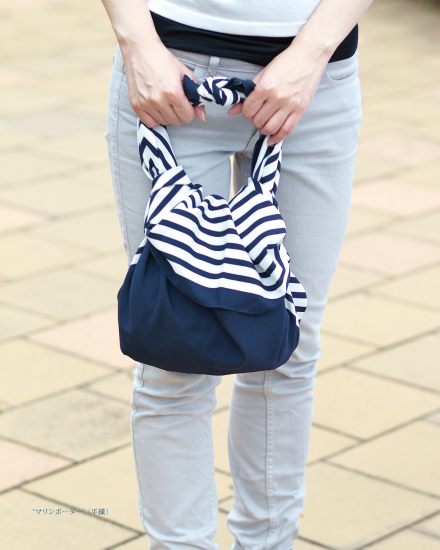
*It can hold up to approximately 10 liters (a bucket full) of water.
materials: 100% Polyester
size: about 96 x 96 cm
weight: about 140g
MADE IN JAPAN
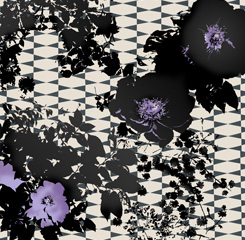
IMPRESSION
designer: Maki Kouno
Purple flowers resting on ink black-colored patterns.
This multi-purposeful design with a soothing shade complements Japanese or Western-style attire.
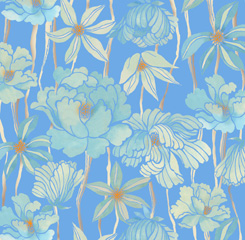
PEONIES AND MUMS
designer: Maki Kouno
Peonies and chrysanthemums are spread large across the fabric.
The Chinese-style blue is a fresh hue.
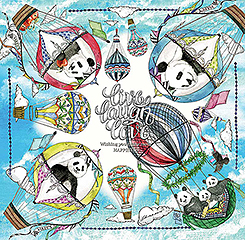
Panda
designer: Masumi Hotta
A panda family is riding in a hot-air balloon in the blue sky. The motif drawn in watercolor is printed. Its bright design would lighten your heart. You can enjoy the vivid colors of watercolor in this furoshiki.
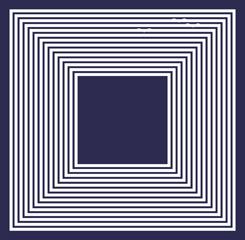
MARINE STRIPES
designer: Jun Ito
The stripes are designed to look nice when wrapped in shape of a bag.
It is a variation of the standard structure of furoshiki, so go ahead and wrap up a square box, you'll love how it looks.
When you look closely, some borders will seem incomplete. As if sea gulls were flying away...
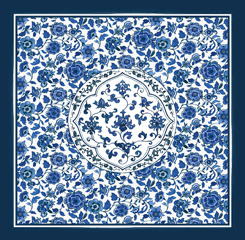
SOMETSUKE
designer: Maki Kouno
This pattern adopts the images of white x marine blue (lapis lazuri) of Imari that is one of the top brand in the world of porcelain for long time, and also accepts the penmanship of porcelain colorations. At the same time we pay our homage to the Japanese pottery cultures and the artisans' techniques from the Jomon period of several thousand year ago.
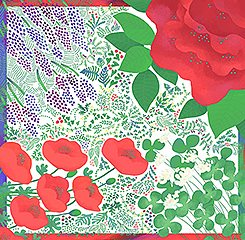
Wrap with flowers
designer: MIYA JUNKO
With an image of such scenes that you wrap a precious item or present, flowers are depicted on the furoshiki to add a colorful impression to wrapped contents. Large flowers arranged at the four corners are seen by ways of wrapping providing different moods depending on the kind of flowers depicted.
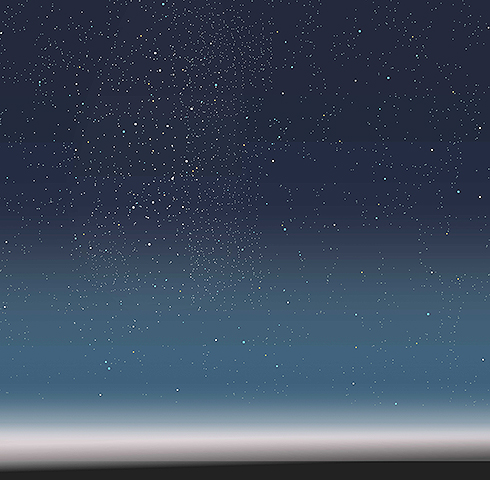
STARRY SKY
designer: Sara Kikkoji
This is an image of a winter starry sky. When water is repelled, the water drops make the starry sky twinkle.

Wrapping with the Night Forest
designer: MIYA JUNKO
A forest illuminated by a large full moon. The unobtrusive pattern drawn in dark blue and white is sedate. Since the pattern is divided into two large halves, detailed pattern of plants and simple pattern, you can show each half as desired.

TOUCAN PARADISE
designer: Akiko Maruyama
This is a combination of agave, the most majestic of succulents, and the fluffy and charming toucan. The coexistence of these different images creates an interesting visual effect when wrapping in the furoshiki. This is a vivid and impactful pattern not only when spread out, but also when wrapped around things and partially displayed.
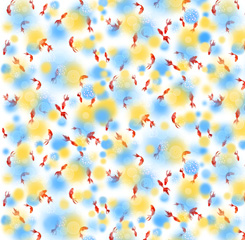
GOLDFISH
designer: Miki Takahashi
Goldfish swimming in the water call forth a cool breeze.
This familiar fish has been loved by the Japanese since the Edo-period (from 17th century to mid-19th century).

NOSHI (Abalone)
designer: ASAKURA SENPU Co., LTD
This design represents the traditional “abalone dried in thin strings.”
Great for New Year's otsutsumi or weddings.
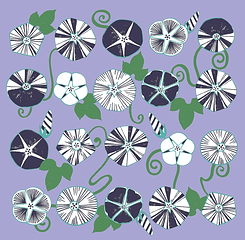
Morning glory
designer: Maki Kouno
In a horticulture boom of the Edo-period (from 17th century to mid-19th century), cultivation of morning glory was popular. With the image of "hana-awase (flower contest)" in which the quality of various kinds of morning glories was judged, its bold and light design like the yukata (summer kimono) for a summer festival is made with various tie-dyed patterns.
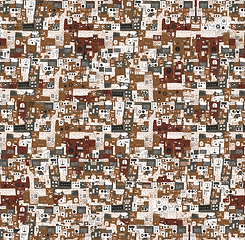
machine
designer: Takuya Suga
It is a pattern of various machines of pictures colored at random using brown and gray as the base.Based on a musical image of synthesizer and speaker as well as an industrial image of series of various machines in line, we have pursued a pattern to be loved by not only young ladies but men as well.
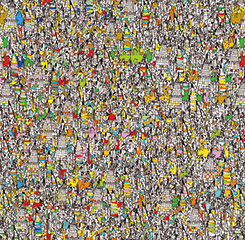
SMILEY TOWN
designer: Takuya Suga
It is a furoshiki of a completely new atmosphere which wasn't seen in the lineup of "NAGARE" in the past. Colors of green, yellow, and red inserted into a town in the best placement are pleasant to the eye, so its design makes you want to use it in various situations.
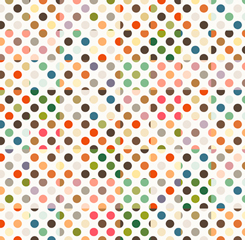
COLORFUL
designer: Motohiro Ohsawa
It is the mysterious pattern which seems like many squares stand out in polka dots. Even though it uses Japanese classic colors, the image of this pattern is very modern and gives you a pop feeling.
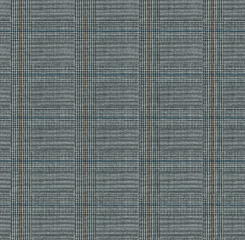
GLENURQUHART CHECK
designer: ASAKURA SENPU Co., LTD
A trad glenurquhart check originally from Scotland.
Orange and blue add a little splash of color to this gray base.
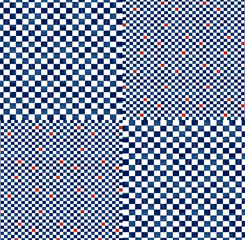
ICHIMATSU
designer: Maki Kouno
It's a traditional Japanese checkerboard pattern. Big patterns and small patterns are divided in quarters. When you wrap a present with this furoshiki, you can put the small checkerboard pattern in front or the big one in front as you like.

COLORFUL FOREST
designer: Tsuyoshi Nemoto
Only ink-jet textle printing can derive this good balance of colors. Mysterious creatures live in the forest and they inspire our imagination.It is very beautiful and unique pattern for furoshiki.

KAKA
designer: Maki Kouno
Poppy patterns with various kind of Japanese flowers. Big and small flowers are overlapping each other which makes this pattern very splendid like a color palette.

ENDLESS KNOT
designer: Jun Ito
The original hexagonal pattern is reminiscent of Edo faceting (cut glass). The repeated motif is a knot called an "endless knot" or "treasure knot," which is one of the eight auspicious symbols in Buddhism.
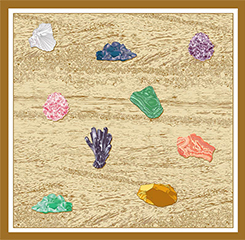
Stone story
designer: Minori Fujita
Ores and minerals have their own meanings and wishes, such as healing, harmony, and love. This pattern is designed based on the cross-section of the geological strata with such ores and minerals. The name ""Stone story"" represents the geological history as a story.
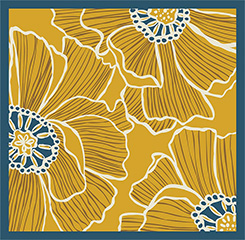
Daisy
designer: Chie Okamura
Scandinavian design of daisies with line drawings. When wrapped around an object, the lines of the petals look like a border pattern, making it easy to use in everyday life. The calming colors are reminiscent of ""just as it is,"" which is the language of the yellow daisy flower.
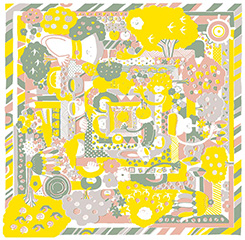
Kurukuru world
designer: Tsuyoshi Nemoto
A ""happy yellow"" world. Flowers, birds, and characters live smilingly in a yellow world. The square pattern spreading out from the center is reminiscent of a picture frame, giving it the appearance of trick art.
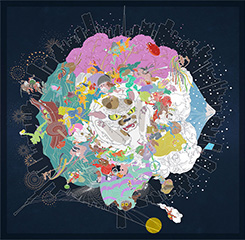
MONONOKE NIGHT
designer: OGAMI RENA
The motif is based on the picture scrolls of "Hyakki Yagyo," which depicts Japanese folk monsters parading through the night. In four seasons, mononoke (Japanese folk monsters) take night tours through modern nighttime streets, with some of them enjoying modern amusements such as smartphones and drones. A curled-up monster cat lurks in the center, which becomes the bottom when wrapped.

Otome Camellia
designer: Maki Kouno
The scientific name of the camellia is Camellia japonica. It is one of the most representative flowers of Japan. Among them, the otome camellia is said to be loved by world-famous fashion brands because of its perfect beauty. This design features a gentle color scheme reminiscent of the salmon-red and baby pink otome camellia.
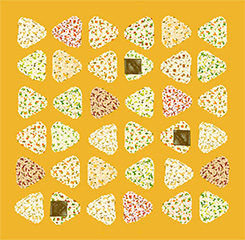
Rice ball
designer: Ayana Ishikawa
Rice ball is a food often eaten when going out. A closer look reveals many colorful ingredients such as mustard greens, sesame, and baby sardines. It is our hope that you will use the furoshiki brightly and happily with the colorful mixed rice balls.
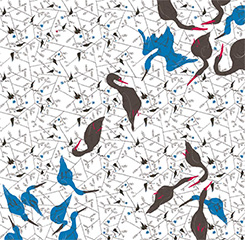
Birds
designer: MIYA JUNKO
This depicts many birds perching on the branches as seen from below. Large birds with silly expressions and small birds with flowers in their mouths seem to be chatting with each other. Using a white base with cleanliness, the design is humorous yet easy to use in daily life.

Flower Dance
designer: Yuri Kitamura
This is a gorgeous furoshiki design with various flowers blooming like dancing. It is designed to make your daily life more gorgeous with its use.
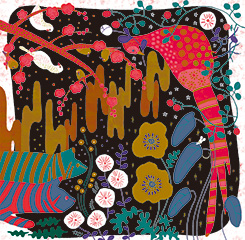
Glory of Nature
designer: MIYA JUNKO
With a nod to Taisho Modernism, glossy and graphical flowers, berries, and living creatures are depicted. The combination of various patterns makes it enjoyable not only when used as a wrapping cloth, but also when spread out.
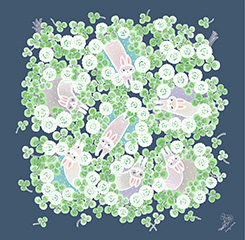
Rabbit and Clover
designer: Hiroko Sueyoshi
This furoshiki has a flower crown motif with bouncing rabbits and fluffy white clover blooming gently. A lucky four-leaf clover is hidden inside the flower crown.

Wrapping in home
designer: MIYA JUNKO
This furoshiki features a variety of intricately interwoven houses, as well as the people and animals living there, like a trompe l'oeil painting. It is made up of a limited number of bright colors, so it is not too flashy, and the fun designs depict various scenes.
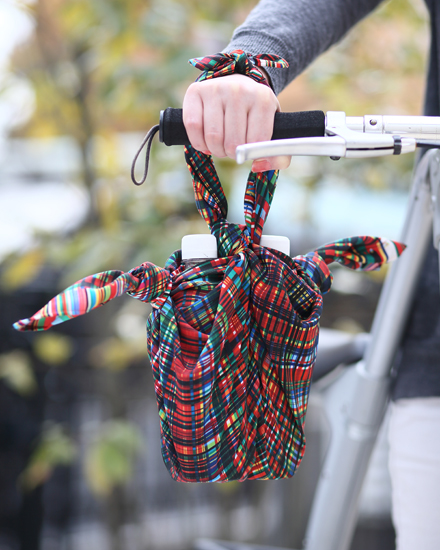
materials: 100% Polyester
size: about 70 x 70 cm
weight: about 85g
MADE IN JAPAN
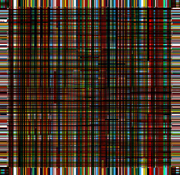
FLAG CHECK
designer: Jun Ito
The check design woven with flags of 204 countries and regions.
This is a new interpretation of the flags of nations.
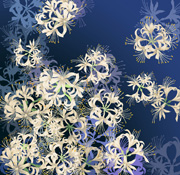
MANJUSHAGE
designer: Maki Kouno
Manjushage is an alias of spider lily, which blooms during equinox.
Commonly displayed in red, but you can find the white blossom variety.
The elegant floral pattern brings alive the elegant white color.
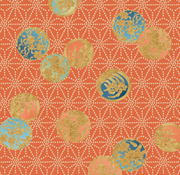
NEO HEMP LEAF
designer: Maki Kouno
Asanoha (hemp leaf) pattern was popular in short-sleeved Kimono during the Edo-era (from 17th century to mid-19th century).
Plum and cherry blossoms, narcissus and Japanese iris were drawn into a circle, and it became a very stylish modern Japanese design.
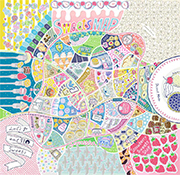
Sweets map
designer: Hiroko Sueyoshi
This colorful sweets map is based on an imaginary city. The city has every kind of sweet you can think of, not only Japanese and Western sweets, but also drinks, jams and more. Please take the fun map with you and visit different places.
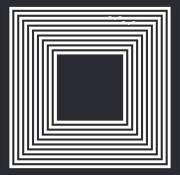
MARINE STRIPES(70)
designer: Jun Ito
The stripes are designed to look nice when wrapped in shape of a bag.It is a variation of the standard structure of furoshiki, so go ahead and wrap up a square box, you'll love how it looks.When you look closely, some borders will seem incomplete. As if sea gulls were flying away...
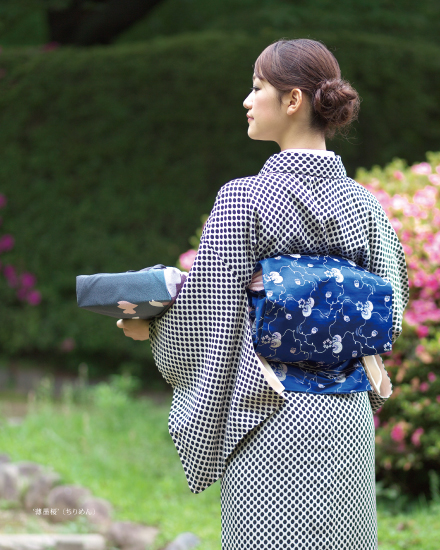
*Crinkled crêpe fabric uses twisted thread, which creates bigger gaps in the weave pattern and, unlike the plain weave fabric, cannot hold water.(It can repel water)
materials: 100% Polyester
size: about 96 x 96 cm
weight: about 165g
MADE IN JAPAN
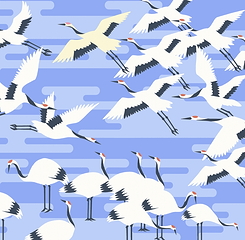
TAZUKASUMI
designer: Maki Kouno
"Tsuru-zu Shita-e Waka Kan (poem scroll with underpainting of cranes)" by Sotatsu Tawaraya, the founding father of a Japanese art style "Rinpa," is its image sauce. "Tazu" is an old term for crane in Manyo-shu (the oldest anthology of tanka). Though a traditional pattern "Kasumi-mon " is used for its background, it has a modern design of the flying crane in the sky of the new era Reiwa.
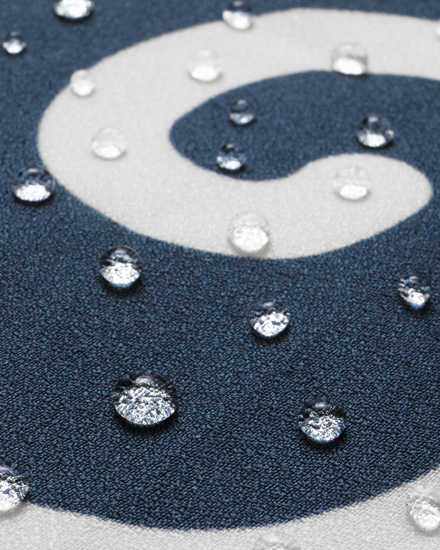
*Amundsen uses twisted thread, which creates a larger weave pattern, but it can hold about four liters of water. It is not recommended for transporting water because any more water will result in a leak.
materials: 100% Polyester
size: about 128 x 128 cm or 70 x 70 cm
weight: about 200g or 60g
MADE IN JAPAN
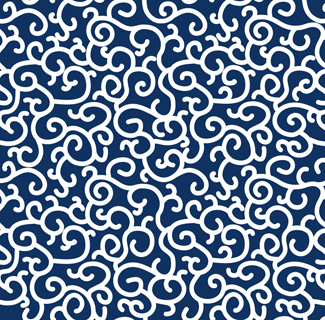
ARABESQUE
designer: ASAKURA SENPU Co., LTD
When thinking of furoshiki, arabesque comes to mind.
Instead of the standard green, we gave it a twist with indigo-like blue.
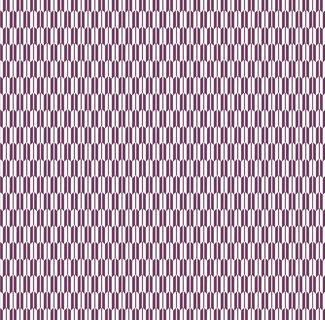
FLIGHT PATTERN
designer: ASAKURA SENPU Co., LTD
Retro purple arrow feathers reminiscent of Taisho (early 20th century) Romanticism.
The arrow feather design has been loved over the years as a good luck charm to repel misfortune at religious ceremonies and seasonal festivals.
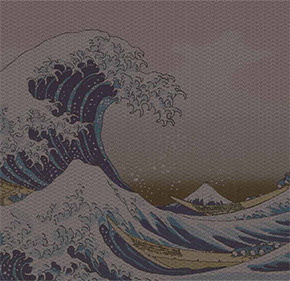
GREAT WAVE
designer: Jun Ito
A traditional pattern of SEIGAIHA (blue ocean waves) is superimposed on the masterpiece “The Great Wave off the Coast of Kanagawa” from “Thirty-six Views of Mount Fuji” by Katsushika Hokusai (1760-1849), and printed on a large furoshiki. Depending on the way it is wrapped, the pattern changes its appearance to black, blue or mainly pink, making it an easy-to-use pattern. Also suitable as a gift for people overseas.
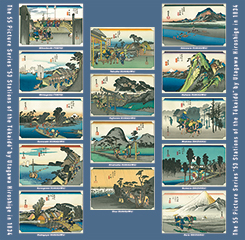
53 Stations
designer: Jun Ito
We produced a large furoshiki featuring masterpiece of Utagawa Hiroshige (1797-1858), The Fifty-Three Stations of the Tōkaidō. This piece is printed with the following stations: Nihonbashi, Shinagawa, Kawasaki, Kanagawa, Hodogaya, Totsuka, Fujisawa, Hiratsuka, Oiso, Odawara, Hakone, Mishima, Numazu, and Harajuku.
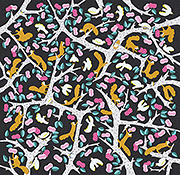
Squirrels on trees
designer: Hiroko Sueyoshi
An above view of many squirrels and birds living on trees is drawn. To be approachable for adults in spite of its animal design, its color scheme is slightly dry with the dark gray background.
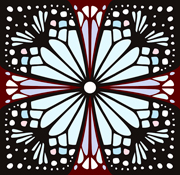
ASAGI
(Pale blue-green)
designer: Naomi Shirai
This furoshiki's motif is Parantica sita. This butterfly has elegant wing and flies long distance. Parantica sita's scales has an effect of water repellent so it is the best motif for NAGARE.
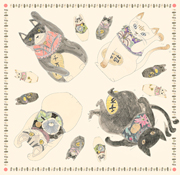
THE CATS OF WEALTH
designer: Chiemi Itoi
Many Maneki-neko, or beckoning cats are radially drawn utilizing a pen, watercolor paints and colored pencils. They are believed to draw happiness and fortune, by beckoning with one paw. Please wrap up what you choose in the Furoshiki together with fortune they bring in.
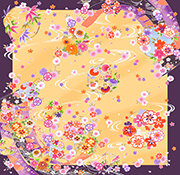
Chiyogami
designer: Chie Okamura
Decorative paper, flower floating, flowers of eternity, flower kimono The design is intended to evoke an image of a time that is both glamorous and elegant. The composition features a warm breeze blowing through a bamboo blind, scattering flower garlands and cherry blossoms.
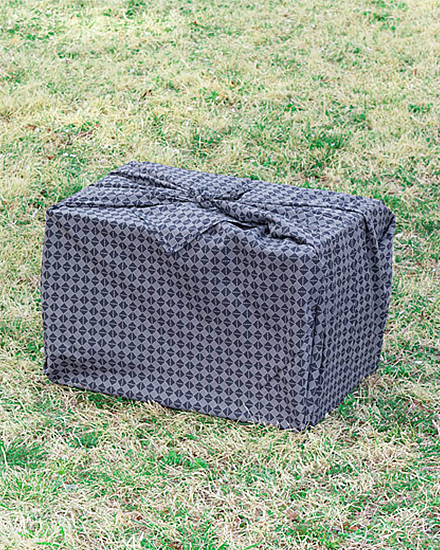
A tough taffeta Furoshiki in 125-cm size can hold and carry as much as 20 liters of water.
materials: 100% Polyester
size: about 125 x 125cm
weight: about 160g
MADE IN JAPAN
Pixeled Ichimatsu pattern
designer: ASAKURA SENPU Co., LTD
Ichimatsu pattern, a Japanese classic checkered pattern is drawn on Furoshiki
with dots in aubergine which is fit for people of all ages regardless of sex.
(*Ichimatsu pattern was first sawn in Haniwa figurine’fs costume in Kofun period around 3th century,
then used by only noble persons, but became popular among citizens in Edo period(1603-1868) when Kabuki actors started wearing this pattern costume)
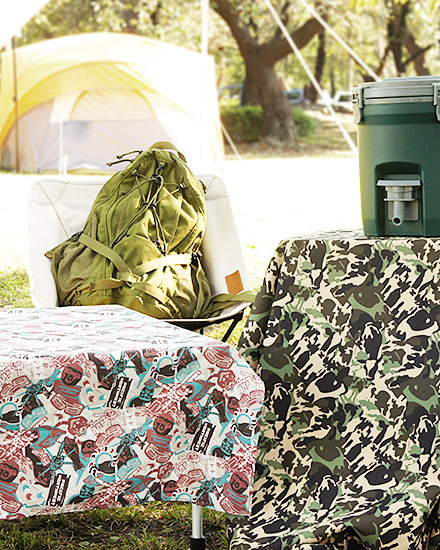
materials: 100% Polyester
size: about 125 x 125cm
Furoshiki weight:about 160g
Case weight: about 10g
MADE IN JAPAN
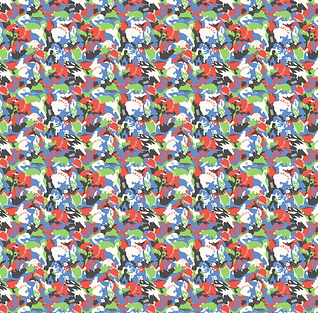
AKAYA'S ANIMALS
designer: iicamo
In agreement with the Akaya Project initiative from the Nature Conservation Association of Japan which aims for the restoration of biological diversity and the creation of sustainable communities, Akaya’fs Animals features a camouflage pattern with a motif of the rare animals that live in the 10,000-hectare national forest, Akaya Forest, that extends across the border between the northern part of Gunma Prefecture’fs Minakami-machi and Niigata Prefecture.
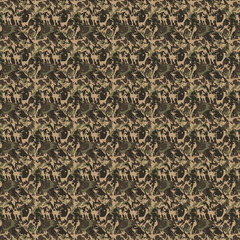
COW
designer: iicamo
Cow-motif Camouflage hide pattern. Cows swarm leisurely, feeding on hay in various parts of the pattern. Maybe you and your friends should try to find out cows in the characteristic mottled pattern with lots of laughs and good fun.

NATIVES
designer: iicamo
Totem pole-themed camouflage pattern. What you can see here and there are hiding various
characters in legends and mythology passed down from generation to generation among aboriginal
people living in northwest coastal area facing the Pacific Ocean in North America.
It is nice to look at their facial expression full of life and showing something humorous.